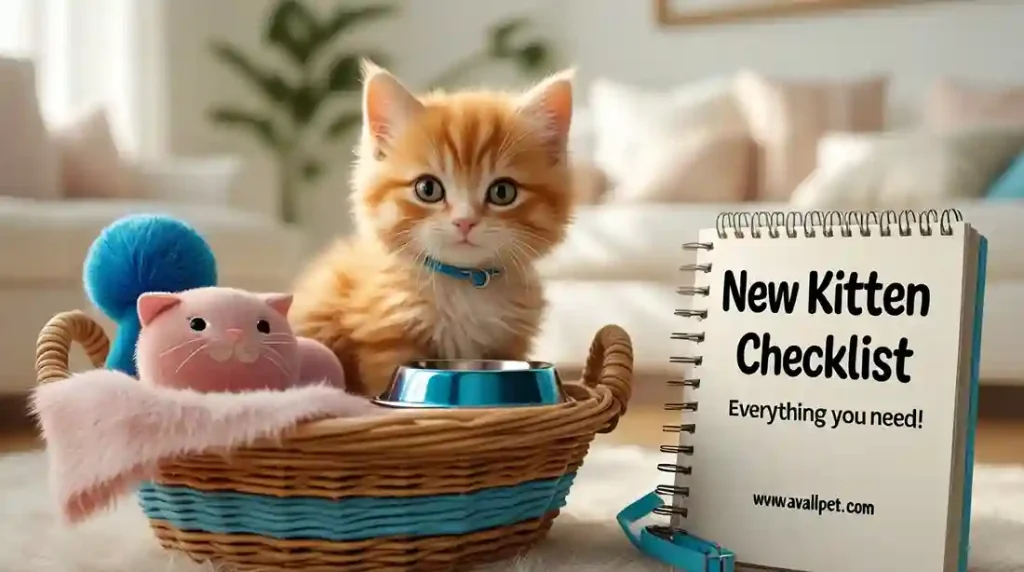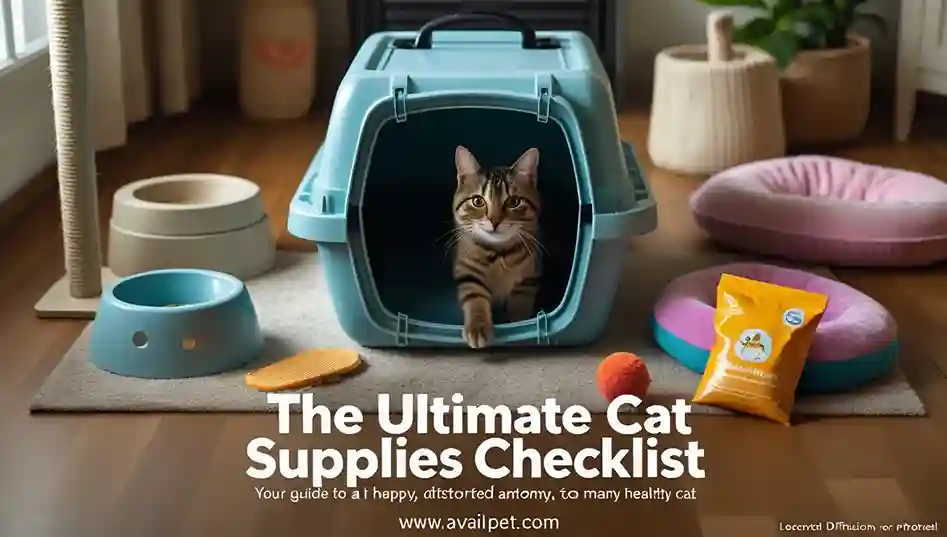Finding a puddle on your rug or a pile in the corner is more than just a messy inconvenience—it’s a cry for help. Your cat isn’t being spiteful or “bad”; they are communicating that something in their world is fundamentally wrong. Inappropriate elimination is one of the most common and frustrating issues cat owners face, but it’s also one of the most solvable.
The key is to stop treating the symptom and start diagnosing the root cause. The solution almost always lies in one of five areas: a hidden medical problem, a litter box setup that fails their instincts, overwhelming stress, or a combination of these factors. Often, the issue begins with a setup that violates core feline needs. If you haven’t yet, our Cat Litter Box Setup Guide is the best place to start troubleshooting.
At AvailPet, we provide clear, actionable steps backed by veterinary expertise. This guide will walk you through a proven, 5-step framework to diagnose why your cat not using litter box and implement the exact solutions needed to restore peace and cleanliness to your home.
Key Takeaways: Cat Not Using Litter Box
Before diving into the detailed steps, here are the most critical insights from our veterinary consultants and behavior specialists:
- 🩺 Medical First: A sudden change in litter box habits is a potential medical emergency. Rule out health issues like UTIs, crystals, or arthritis with your vet before addressing behavior.
- 📍 Location Decodes Cause: Where your cat eliminates reveals the problem. Spots near doors/windows suggest territorial stress, while accidents near the box often point to litter aversion.
- 🧼 Clean with Enzymes: Standard cleaners are useless. You must use an enzymatic cleaner to completely break down urine crystals and prevent repeat offenses.
- 📦 Setup is Foundational: Most problems stem from violating the golden rules of litter box setup. Review our Cat Litter Box Setup Guide to audit your current arrangement.
- ⏰ Act Quickly: The longer the behavior continues, the more it becomes a hardened habit. Prompt, consistent action is key to a successful reset.
The 5-Step Diagnostic Framework
Follow this proven, sequential process to systematically identify and solve your cat’s litter box avoidance. Do not skip steps.
STEP 1: The Non-Negotiable Vet Visit
This is always your first action. Pain is the most common reason a cat suddenly abandons their litter box.
- Urgent Red Flags: Straining to urinate, crying out in the box, blood in the urine, or frequent attempts with little output. These can signal a life-threatening urinary blockage.
- Common Medical Causes: Urinary Tract Infection (UTI), bladder stones, arthritis (making entry painful), diabetes, or kidney disease.
- What to Bring to the Vet: Photos of the accident locations, a log of when they occur, and any notes on changes in water consumption or behavior.
STEP 2: Analyze the Evidence – Become a Feline Detective
Once medical issues are ruled out, the location and pattern of accidents are your biggest clues.
- Location Analysis:
- Right Next to the Box: Often signifies litter box aversion. The cat wants to use the right spot, but something about the box itself is unacceptable (too dirty, wrong litter, pain upon entry).
- On Doorways or Windows: Typically indicates territorial stress or anxiety, often triggered by outdoor cats, new pets, or changes in the household.
- On Soft Surfaces (Beds, Laundry, Couches): Can be linked to comfort-seeking behavior, which is commonly associated with medical issues like UTIs or general anxiety.
- Pattern Recognition:
- Spraying (backing up to a vertical surface with a quivering tail) is marking behavior.
- Inappropriate Elimination (squatting on a horizontal surface) points to a box, medical, or stress issue.
STEP 3: The Litter Box Audit
This is where you scrutinize every aspect of your current setup against feline preferences.
- Number Check: Are you following the N+1 rule? (One cat = two boxes, two cats = three boxes). Insufficient boxes are a top cause of problems in multi-cat homes.
- Location Review: Is the box in a quiet, low-traffic area with multiple escape routes? Revisit the core principles in our Cat Litter Box Setup Guide.
- Type & Size: Is the box uncovered, and is it large enough (at least 1.5x your cat’s length)? A box that’s too small or covered can be a major deterrent.
- The “Litter Buffet” Solution: Set up 2-3 temporary boxes side-by-side, each with a different type of litter (e.g., unscented clumping clay, fine silica crystals, soft paper). Your cat’s choice will tell you their new preference.
STEP 4: Nuclear Clean-Up Protocol
If you don’t completely remove the scent, your cat will be drawn back to the same spot.
- The Essential Tool: An enzymatic cleaner is non-negotiable. Only these cleaners break down the uric acid crystals that form in dried urine, which are undetectable to the human nose but act as a beacon for cats.
- The Process: Soak the area thoroughly, allowing the enzyme cleaner to penetrate deep down. Let it air dry completely. Avoid ammonia-based cleaners, as the smell mimics urine and can attract cats back.
STEP 5: Behavior Reset & Retraining
For persistent cases or to establish new, positive habits.
- Positive Reinforcement: Keep high-value treats near the box. When you see your cat use it correctly, immediately reward them with praise and a treat.
- Stress Reduction: Use Feliway diffusers (synthetic calming pheromones), increase daily play sessions to burn anxiety, and create vertical territory with cat trees.
- Confinement Training: For severe or persistent cases, confine your cat to a small, easy-to-clean room (like a bathroom) with their bed, food, water, and a pristine litter box. This “resets” their habits. Once they are reliably using the box for several days, gradually give them more access to the house.
Special Scenario Solutions
Some situations require a more tailored approach. Here are targeted solutions for common, complex scenarios.
For Multi-Cat Households: Managing Territory and Tension
In homes with multiple cats, litter box issues are often rooted in social dynamics.
- Identify the Target: Is one specific cat being bullied or blocked from a box? Watch for subtle signs like one cat guarding a hallway or hissing when another approaches the litter area.
- Strategic Box Placement: Do not place boxes next to each other. Scatter them in different rooms to prevent one cat from guarding all access points simultaneously.
- Create “Safe Passage”: Ensure each box has multiple exit routes so a cat never feels trapped. Avoid placing boxes in dead-end corners.
- Amplify the N+1 Rule: In tense multi-cat situations, you may need to provide even more than the standard N+1 boxes to diffuse competition.
For Senior Cats: Accommodating Age-Related Changes
Older cats have different physical needs that can directly impact litter box use.
- Address Mobility & Pain: Arthritis is extremely common in seniors. Provide low-entry boxes (or cut a low opening in a standard box) and ensure they are placed on every floor your cat uses to avoid painful stairs.
- Consider New Health Issues: Senior cats are prone to conditions like kidney disease (causing more frequent urination) and cognitive decline (causing confusion). More frequent box cleaning and a consistent, easy-to-find location are crucial. Our guide to Cat Litter for Senior Cats covers ideal litter choices for their needs.
- Improve Accessibility: Use night lights to help guide them to the box and ensure the path is always clear of obstacles.
After Major Life Changes: Easing the Transition
Any significant change in the environment can trigger stress-related elimination.
- After a Move: Confine your cat to a single, quiet “base camp” room (like a bedroom) with their litter box, food, and water for the first few days. This gives them a safe territory to adjust from before exploring the whole house.
- Introducing a New Pet or Baby: Maintain your cat’s routine as much as possible. Provide them with a “safe room” where the new arrival is not allowed, complete with their own litter box, food, and water. Use pheromone diffusers (like Feliway) in this area and common spaces to promote calm.
FAQs: Cat Not Using Litter Box? Emergency Solutions
How do I stop my cat from peeing on my bed?
This is a common but complex issue. First, rule out a Urinary Tract Infection (UTI) with your vet, as this is a primary cause. If medical issues are cleared, it’s often a sign of severe anxiety or a marking behavior due to stress (e.g., a new pet, a change in routine, or an outdoor cat nearby). Immediately restrict bedroom access, wash your bedding with an enzymatic cleaner, and place a litter box in the room (if possible) or a Feliway diffuser nearby.
Why did my cat suddenly stop using the litter box?
A sudden change almost always points to a medical problem or a sudden, significant stressor. The very first step is a veterinary visit to rule out painful conditions like a UTI, bladder stones, or arthritis. If they get a clean bill of health, investigate any recent changes in your home: new pets, people, furniture, cleaning products, or litter?
Is my cat doing this for revenge?
No. Cats do not possess the complex emotional capacity for revenge or spite. Inappropriate elimination is a symptom of an underlying issue—be it pain, fear, or stress. Interpreting it as revenge will lead you to incorrect, punitive solutions that will worsen the problem.
How long does it take to retrain a cat?
There is no fixed timeline. With a consistent, multi-pronged approach (medical care, perfect setup, proper cleaning, and stress reduction), you may see improvement in a few days to a few weeks. However, for deeply ingrained habits or in multi-cat households with complex dynamics, it can take several months of persistent management.
What if nothing works?
If you have diligently followed all steps—vet check, setup audit, proper cleaning, and stress reduction—without success, it’s time to escalate. Ask your veterinarian for a referral to a veterinary behaviorist. These are vets with specialized training in animal behavior who can diagnose complex issues and prescribe anti-anxiety medications if needed.
When to Call for Professional Help
While most litter box issues can be resolved with the steps outlined in this guide, some situations require specialized expertise. Recognize these signs to know when it’s time to seek advanced help.
- Persistent Problems After Medical Clearance: If your veterinarian has ruled out medical causes, but the inappropriate elimination continues for more than 2-3 weeks despite your consistent efforts, a deeper behavioral issue is likely at play.
- Signs of Severe Aggression or Anxiety: If the litter box issue is accompanied by intense aggression between cats, extreme fearfulness, hiding, or other compulsive behaviors, the problem is more complex than simple litter box aversion.
- Household-Wide Stress Affecting Multiple Pets: When the problem is not isolated to one cat and is causing a cascade of stress and behavioral issues throughout your multi-pet household, a professional can help you restructure the entire dynamic.
- You Feel Overwhelmed and Out of Options: Your mental health matters. If the situation is causing significant distress and you’ve run out of ideas, a professional can provide a structured, supported plan and relieve the burden.
In these cases, ask your primary veterinarian for a referral to a board-certified veterinary behaviorist or a certified cat behavior consultant. These experts can develop a comprehensive treatment plan that may include advanced behavior modification techniques and, if appropriate, medication to reduce anxiety.
Conclusion: From Frustration to Solution
Dealing with a cat who refuses the litter box can feel like an endless, discouraging battle. But as this guide has shown, it is a battle you can win. The path forward is not about punishment or guesswork, but about methodical problem-solving rooted in understanding your cat’s needs.
Remember, the journey begins and often ends with the fundamentals: that crucial vet visit, a meticulous litter box setup audit, and relentless cleaning with the right products. By addressing the root cause—whether it’s pain, stress, or a simple dislike of their bathroom arrangements—you are not just cleaning up messes. You are restoring your cat’s well-being and the peace of your home.
Be patient and consistent. For ongoing support and to ensure your setup is optimized, our comprehensive Cat Litter Guide remains your best resource for long-term success.
Sources
- Cornell Feline Health Center – Litter Box Problems
- International Cat Care – Litter & Litter Boxes
- ASPCA – Litter Box Care
Disclaimer: This guide provides general advice for common scenarios. We are not veterinarians. A cat suddenly avoiding the litter box can signal a serious medical emergency. Always consult your veterinarian immediately for diagnosis and treatment of health issues. For persistent behavioral problems, we recommend consulting a certified veterinary behaviorist.






